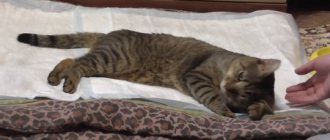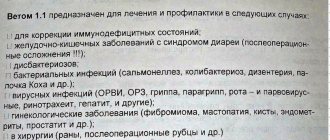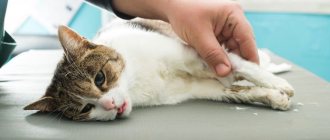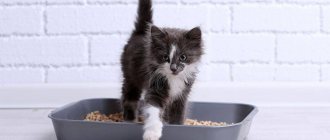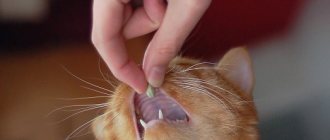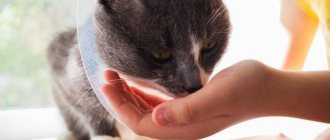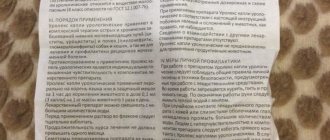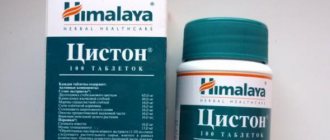Symptoms and causes of constipation
Even when experiencing discomfort for a long time, animals may not demonstrate their discomfort to the owner in any way. Only sensitivity and attention will help you notice in time that your pet has problems with bowel movements. Please note if your dog is unable to have normal bowel movements during a walk. In severe cases, the dog lies down and moans. Her belly becomes swollen and hard to the touch.
Before choosing a treatment method for constipation, you need to understand what causes it.
Poor nutrition
A sudden transition to dry food, the presence of bones in the diet, especially boiled ones, the lack of plant fibers in food, the abundance of fastening products - all this provokes difficulties with emptying.
Water scarcity
Remember that dogs do not drink stagnant water. Make sure your pet always has access to clean water. The need for fluid increases if you feed your dog dry food, if it’s hot outside, or if the dog leads an active lifestyle. When there is a lack of water, the body uses fluid from the large intestine. Feces become dry and injure the delicate mucous membrane.
Helminths
Parasites damage the villi in the intestines and disrupt the normal metabolism of nutrients and fluids. This can lead to both constant diarrhea and severe constipation.
Intestinal blockage with hair
Cats most often suffer from this problem, but dogs can also absorb fur along with food. Why does it accumulate in the gastrointestinal tract, creating lumps and interfering with the passage of feces.
Chronic diseases
Difficulties with emptying lead to inflammation of the anal glands, as well as diseases of the genitourinary system: prostatitis in males, inflammation of the appendages in females.
Lactusan for cats dosage for constipation
Owners should know the symptoms of diseases, as well as what medications should be given in a particular case. Wonderful medications have been developed that can solve many cat health problems. These are Lactusan and Duphalac.
Constipation in pussies is common, especially in older pets. Their immunity to infections is already weakened, and their gastrointestinal tract does not function well. Peristalsis works worse than in young and healthy cats. Food is not digested properly.
In young cats and kittens, the occurrence of constipation depends on many factors. Most often from improper or poor-quality nutrition.
If there is no fiber or protein in the daily diet, the animal drinks little water or eats a lot of bones, bone tissue is poorly digested and clogs the stomach.
The cat may be under stress. This causes one-time constipation. It is possible that a foreign body has entered the intestines and is interfering with normal bowel movements. For example, a piece of wool. In this case, only surgery will help. Therefore, if you see symptoms, go to the vet immediately!
When constipation occurs, the cat does not behave as usual. She sits in the tray for a long time, strains, rummages around in it - she cannot find a place for herself. Screams loudly or rolls on the floor. May frequently enter the litter box. This behavior indicates that the cat cannot go to the toilet.
This disease appears more often in older cats. The kidneys do not perform the function of removing toxins from the body. The water balance is disturbed. Owners do not notice signs of chronic renal failure immediately, but only when acute failure becomes chronic, and the pussy is deeply sick. If you regularly visit the veterinarian, this will not happen.
The owner needs to pay attention if the cat begins to drink more and pees a lot.
It is very important to notice and consult a doctor in time, especially if the disease occurs frequently and does not go away for a long time.
If the veterinary clinic is far away and it is not possible to travel quickly, you can get help at home, but a visit to the doctor cannot be postponed. There are medications that will bring your cat's health back to normal.
Buy Lactusan for cats or Duphalac. Be sure to read the instructions in the package.
Lactusan is a mixture of beneficial bifidobacteria and lactobacilli. Available in the form of suspensions, syrups, tablets. Lactusan for cat constipation is the most popular remedy. The drug is also prescribed for dysbacteriosis. Is a prebiotic.
Has a laxative effect. Softens feces and facilitates the process of defecation. It should be given to the animal after eating. The medicine may cause allergies. Therefore, after taking it, keep an eye on your cat. If you notice a bad reaction, replace the drug with another, hypoallergenic one.
Consists of lactulose - more than 36%, citric acid, lactose and galactose.
Lactulose is an important component in drugs for the treatment of the gastrointestinal tract and dysbiosis. Creates beneficial microflora in the intestines. Inhibits pathogenic microflora and removes toxins from the body.
Lactose is milk sugar that is beneficial for the gastrointestinal tract.
Galactose is a component of whey. Present in medications for dysbiosis.
Lactusan prevents carcinogens from entering the circulatory system. The drug is administered to the animal orally. The dose of Lactusan is prescribed depending on the age of the animal and its weight - from 1 milliliter. For adult and old cats - no more than 3 ml per dose, three times a day. In the annotation for the drug, the dosage is indicated in great detail. The wrong dose of medication can harm your pet.
In case of renal failure, the doctor’s goal is to prevent the processes of putrefaction in the animal’s intestines, since putrefaction contributes to the stagnation of ammonia in the body. Lactusan is the most suitable drug for this purpose. It helps reduce ammonia in the gastrointestinal tract and ensures normal microflora. Lactusan cleanses the blood and actively removes toxins and waste from the body through the intestines. As a result, creatinine and urea, the level of which is increased in chronic renal failure, decreases. Supports vital kidney functions. It is better to buy Lactusan for pussy in the form of a suspension. In this form, the medicine is easier to administer into the body.
Lactusan is prescribed by a veterinarian, together with other drugs. The dosage for chronic renal failure is 2-3 milliliters per dose.
Along with the drug, it is important to provide the pussy with a diet: reduce meat and protein products in food, give more water.
The laxative medicine for cats Duphalac is also often used for problems with bowel movements. Its constituent component is also lactulose. This drug is milder. It does not begin to act immediately, but several days after administration. Reduces toxins in the intestines.
Duphalac is also prescribed for chronic renal failure. 2 milliliters per dose.
Of course, you can help your cat at home. But it is better to contact a specialist – a veterinarian – in a timely manner. Lactusan and Duphalac are medications. And before using them, you must pass all tests.
source
Almost all owners of domestic cats periodically encounter such a not very pleasant illness as constipation in cats. Mostly older cats are susceptible to constipation, but this problem does not bypass completely healthy and young cats, and even recently born kittens.
Constipation is absent, difficult or insufficient bowel movement, which leads to a large accumulation of hardened feces in the colon, which gives the pet unpleasant and often painful sensations, and over time can lead to quite sad consequences.
Feces that are not removed in a timely manner poison the body and can lead to general intoxication , increasing the load on the excretory internal organs: stomach, kidneys, liver. Over time, progressive poisoning by decomposition products can disrupt the normal functioning of the heart and thereby lead to death.
The most important symptom of constipation is stool retention, which leads to difficulty defecating and hardening of stool. What is considered a delay? Most often, a healthy cat stools once a day, less often - once every two days. In the case when bowel movements are delayed for another day, we can safely talk about constipation. Moreover, the cat may meow pitifully, often try to make unsuccessful attempts to sit in the tray or simply in a secluded corner, trying to get rid of the uncomfortable sensations.
But it also happens that a cat constantly goes to the toilet, but at the same time defecation is difficult, the intestines are not completely emptied, the feces look like small dense nuts or, on the contrary, are very liquid. In this case, chronic constipation can be considered.
The most common symptoms of both chronic and acute constipation are lethargy, lack of appetite in the cat, and sometimes vomiting and nausea . Some pets refuse to eat food and begin to lose weight, some stop licking themselves.
Constipation is not a disease, but more of a symptom, therefore, in order to effectively help your cat, first you need to identify and, if possible, remove the causes of constipation.
Very often, the causes of constipation are explained by the gender or age of the pet:
- In cats, constipation is not as common as in cats;
- In older animals, peristalsis works much worse than in young animals.
Problems with defecation are sometimes caused by an unbalanced cat's daily diet: lack or absence of fiber in the animal's daily menu, insufficient water or eating bones, low amount of protein. E simultaneous constipation is sometimes caused by the stressful state of the pet.
But the cat, one way or another, needs to be shown to a veterinarian, since irregular, painful bowel movements or stool retention can also create more serious causes that are associated with neurological and orthopedic disorders, disorders of the internal organs.
Thus, during the examination, the veterinarian may identify:
- orthopedic problems that prevent the cat from taking the required position for defecation;
- accumulated pieces of ingested fur (trichobezoars) that need to be surgically removed;
- megacolon - deterioration of intestinal motility along with a significant increase in its size;
- strictures - cicatricial narrowing of the anus;
- inflammatory processes, perineal hernia, tumors, hyperplasia, some other diseases that the cat’s owner may not even be aware of;
- entry of a foreign body into the digestive system.
In a veterinary hospital, additional examination methods are performed:
- Ultrasound of internal organs;
- blood tests;
- X-ray examination.
If your cat has not eaten for several days, your veterinarian may prescribe an infusion drip to prevent dehydration.
If for certain reasons constipation in a pet occurs periodically, then, first of all, you need to learn how to cope with constipation at home. To begin with, you need to pay attention to the following drugs : Vaseline oil, Duphalac, Lactusan. These drugs help soften stool and make it easier to pass through the rectum. The use of castor oil for these purposes is undesirable, as it often leads to significant pain in the cat.
Vaseline oil is given to animals orally several times a day. The dosage is selected individually, taking into account the weight of the pet; it is advisable to consult a doctor on this matter . But if this is not possible, then you need to start with a minimum dosage of 6 ml and look at the results. An adult cat weighing approximately 7 kg needs approximately 50-60 ml of Vaseline oil.
It is best to give the oil on an empty stomach, as there is a high probability that after eating the food, the cat will vomit from this procedure. The oil must be drawn into a syringe (without a needle, of course) and poured into the cat’s mouth with a confident and quick movement, trying to hold the syringe slightly to the side so that the oil goes straight into the throat, bypassing the tongue.
Vaseline oil is almost not absorbed in the stomach, unlike all kinds of vegetable oils, so there is no need to change Vaseline oil, for example, to sunflower oil. Moreover, a cat’s consumption of vegetable oils in excessive quantities often leads to liver dysfunction.
Most often, difficult defecation (or its complete absence) is treated with the help of therapeutic drugs that soften the stool. For example, the most popular laxative for cats is Lactusan. This product belongs to the class of prebiotics and is a source of lactulose. The drug restores beneficial microflora in the intestines, while simultaneously protecting the body from toxins, inhibiting pathogenic ones.
The product provides detoxification and reduces the entry of carcinogens into the circulatory system. The drug "Lactusan" gently relieves constipation by activating rectal motility.
In addition to it, Duphalac laxative for cats is often used. This drug also contains lactulose. It stimulates peristalsis and is gentle. The drug "Duphalac" works a few days after administration. This is explained by the fact that this laxative passes through the gastrointestinal tract, reduces the concentration of ammonium ions in the blood by more than 30%, and inhibits the absorption of toxins in the intestines. The dosage of any drug is selected by the veterinarian taking into account the physiological characteristics of the cat, as well as in accordance with the recommendations of the instructions for use of the medicine.
Lactusan, Duphalac and other medications that contain lactulose are given to the animal orally several times a day. The dosage is chosen taking into account the weight of the animal (0.5 ml per kilogram of total weight); for an adult cat, the dose is usually 2.1–2.6 ml. Other laxatives must be prescribed by a doctor and used strictly according to the instructions.
Another effective drug is Prelax children's syrup.
It also contains lactulose and makes it possible to solve the problem of constipation in cats. This syrup has excellent taste , so cats eat it with pleasure.
The syrup can be mixed with dry food. Sodium Picosulfate is also considered an effective drug, but its use must be agreed with a veterinarian , since only he can correctly determine the dosage and frequency of use in a particular case.
There is another drug that is recommended for relieving constipation - magnesium sulfate. To use it, you need to dilute half a sachet in water and give it to your cat. Not all animals calmly use this remedy , since it is quite bitter. It is necessary to draw up the solution with a syringe and carefully pour it into the animal’s mouth. The drug instantly relieves pain in the pet, and after about 6 hours, the laxative begins to take effect.
You can try to cope with constipation using traditional methods, for example, diluted condensed milk with raw water. This mixture has an effect similar to castor oil - it normalizes the emptying of the animal’s rectum and softens stool . Microenemas with a solution of a drug that contains lactulose, for example, Lactusan, are also useful. These enemas can help your pet deal with constipation on its own.
If there are persistent problems with defecation, it is recommended to treat the cat with courses of drugs that normalize the microflora of the rectum.
In particularly difficult cases, when there are obvious signs of intoxication of the body, and constipation cannot be overcome at home, there is a need for a deep cleansing enema .
But for this you need to contact an animal clinic, since this is a rather complex rinsing of the rectum; this cleansing may require more than 7 liters of water. Prevention of constipation in cats does not require much effort, and, as a rule, comes down to the following:
- Periodically give your pet cleansing phytomins for hair removal; they can be purchased at veterinary pharmacies or pet stores. These are drugs that contain lecithin, are usually prepared in the form of tablets or pastes and are used for prevention purposes, as well as to remove the consequences of acute constipation. Most often, in addition to lecithin, phytomins contain herbal extracts that normalize the gastrointestinal tract and relieve inflammation. Phytomines must be used in accordance with the instructions on the package.
- Brush your cat periodically to help it get rid of excess hair. Moreover, this applies to long-haired breeds of cats; they more often than others suffer from the accumulation of tufts of fur in the stomach.
- Provide your cat with constant access to fresh drinking water, especially when the animal’s diet includes dry food.
- Make sure your cat's daily menu contains the required amount of plant fiber and protein. You can use steamed oat or wheat bran as fiber at the rate of one tablespoon per day. A cat's menu must include stewed or boiled vegetables, as well as cereal porridge. When your cat does not refuse to eat pumpkin, it will be an excellent laxative for the cat: one tablespoon of boiled pumpkin daily, added to any dish, can help cope with constant physiological constipation.
- Do not neglect periodic examinations of the animal by a doctor, this can help in a timely manner to prevent illness, which may result in constipation.
- Movement is another very important factor that helps prevent constipation and improve intestinal motility in the animal. If the cat is not free to roam outside, then purchase special exercise equipment or toys for it, they will help the animal move more.
This, perhaps, is the most important thing about such an unpleasant illness as constipation in cats. Let these simple tips and tricks, as well as love and attention to your pet, help you keep your four-legged friend healthy and vigorous.
source
The article gives a general idea of what owners of cats, cats and kittens most often deal with, as well as what advice veterinarians can give them. Leave your tips or recommendations on this matter in the comments.
The simplest laxative for kittens at home is vegetable oil. The desired effect is achieved after 1 drop of oil added to the kitten’s food. A mixture of condensed milk and raw water also has the property of softening feces in the intestines of cats.
However, both methods also have negative consequences. Frequent consumption of vegetable oil has a negative effect on the liver of animals, and condensed milk with water can cause severe diarrhea.
Frequent constipation in kittens indicates poor nutrition or improper care. Perhaps the animals lack water and move little.
Both castor oil and Vaseline and vegetable oils have a laxative effect. Another thing is that with frequent use, vegetable oil causes complications in the liver, and castor oil causes pain in the intestines.
Therefore, if possible, it is better to give the animal Vaseline oil to normalize stool. It is not so harmful to the body, since it is not absorbed by the intestines, causing only softening of the stool. Vaseline oil should be used twice a day (1.5 ml per 1 kg of weight), pouring tiny portions into your pet’s mouth so as not to cause suffocation.
Duphalac is a drug used for hepatic encephalopathy and constipation. In addition to the laxative effect, the medicine reduces the production of toxins in the intestines and reduces the content of ammonium ions in the blood.
The dosage of Duphalac per 1 kg of cat weight is 0.5 ml, i.e. an animal weighing 4 kg should be given 2 ml of the drug at a time.
The effect of the medicine is felt within 12-24 hours. Duphalac is not in short supply and can be purchased at any veterinary pharmacy. The cost of the drug is about 8 dollars.
Laxative drops for constipation in kittens are Duphalac, Prelax and Lactusan. The action of these drugs is based on softening feces and stimulating intestinal motility of the animal.
When using medications, you must strictly follow the recommended dosage.
Laxative for cats Bimin is a drug intended for cleansing the animal’s stomach and intestines of fur deposits, as well as treating and preventing constipation. Bimin is given in a dosage of 0.5 ml/kg for preventive purposes, and 1 ml/kg of cat weight for treatment.
The medicine is administered orally - it is given with a syringe or spoon in the morning, on an empty stomach. The cost of a 30 ml bottle of Bimin is 40 rubles.
A popular laxative for cats is condensed milk with water. To prepare it, add a teaspoon of condensed milk to half a glass of water, mix well and give it to the animal instead of drinking.
Reviews from those who have used this remedy in practice are contradictory, and since the quality of condensed milk often leaves much to be desired, it is better not to experiment, but to give your pet a pharmaceutical drug that has a laxative effect.
Lactusan is a fairly popular carrier product for cats. The medicine inhibits pathogenic and restores beneficial intestinal microflora, protecting the body from toxins and carcinogens.
Lactusan is given to the animal 1-2 times a day. Single dosage – 2-2.5 ml (0.5 ml/kg body weight). Lactusan solution can also be used for microenemas.
The cost of a 100 ml bottle of lactusan is about 30 hryvnia.
source
Constipation is a fairly common occurrence in pets. “Lactusan” for cats will help to cope with them in representatives of the cat family. It is very important to use Lactusan correctly for cats. The dosage indicated for animals of different ages is usually indicated on the drug packaging.
Constipation in cats manifests itself in the inability of the animal to go to the toilet at a certain moment. At the same time, the desire to visit the tray remains. She expresses her dissatisfaction about this in every possible way. For example, he begins to scream throughout the house, throw litter around, and even sit in the litter box, choosing a comfortable position for himself. But the matter is not moving forward. If the owner of the animal notices the listed signs, and, in addition, the need to change the litter, which always remains clean, has disappeared, it means that the representative of the feline family is constipated.
It is very important to help your cat cope with the problem in a timely manner. Not only can constipation be uncomfortable and painful for your pet, but it can also be dangerous to your pet's health. If feces, which contain exclusively body waste, are not removed in a timely manner, this can lead to serious poisoning. Decay products remaining in the intestines can negatively affect the functioning of the heart, kidneys and, of course, the liver. As a result, the appearance of the animal deteriorates significantly. In the most advanced cases, constipation can even lead to death. Therefore, it is necessary to monitor the condition and behavior of your pet in order to help him in time if necessary.
To do this, you will need to give the animal a special drug that will soften the feces and facilitate their rapid elimination from the body. The most popular and widespread of these products is Lactusan. This is an inexpensive and accessible medicine for most buyers, which can easily be found in a veterinary pharmacy.
Some cat owners decide to use petroleum jelly to soften feces instead of a special medicine. But it can only be used for constipation. If there is intestinal obstruction, it is very dangerous for the animal. But it’s difficult to determine exactly what problem a cat has. Therefore, it is better not to take risks.
In addition to the action described above, “Lactusan” is also capable of restoring beneficial intestinal microflora in the animal’s body, which allows you to quickly minimize the negative consequences of constipation. This laxative perfectly fights the pathogenic environment and removes dangerous toxins from the body of a cat.
It is important to consult with an experienced, professional veterinarian before using your chosen medication. Only he will be able to select the optimal dose for the animal, taking into account its breed, weight and general condition of the body. An incorrectly selected dosage may not only not help in combating the problem, but also harm the health of the cat.
If the owner of a feline suffering from constipation does not have the opportunity to visit a veterinarian, and the animal requires urgent help, then the medicine should be given to him according to the instructions on the drug packaging.
It is mandatory to give the animal the drug only after eating. A single dose should not exceed 3 milliliters.
In general, this medicine has no contraindications, with the exception of allergic reactions to some of its components. Therefore, after taking the first dose, it is very important to monitor the condition and behavior of your pet. If any negative reactions occur, it is worth replacing the drug with another one with a similar effect.
Only a veterinarian can find out the main cause of problems with defecation. To do this, he will need to conduct appropriate examinations of the animal and take all the necessary tests from it.
In some cases, constipation in cats occurs simply because they do not drink enough water. Therefore, it is so important to ensure that it always ends up in the animal’s bowl. In hot weather, the amount of fluid he consumes should increase.
Constipation in a cat can be treated with a variety of means, including folk remedies. But it is best to choose a proven medicine with a safe composition for this, which will definitely be effective and efficient and will help to quickly solve the problem.
source
Which laxative for humans is suitable for animals?
When choosing a laxative for your dog, remember that rare drugs from our medicine cabinet help four-legged pets. It's often the other way around. Many of the medications are strictly contraindicated for animals. But there are exceptions here too.
Duphalac
The laxative contains lactulose. This mild medicine has the following effects on the body:
- liquefies feces;
- normalizes intestinal microflora;
- absorbs ammonia and nitrogen, which promotes detoxification;
- slows down the growth of salmonella;
- promotes the absorption of vitamins and minerals from food.
Since the drug does not affect the muscles themselves and the gastrointestinal mucosa, it can be prescribed to dogs. Veterinarians prescribe Duphalac not only for relief, but to restore lactobacilli. The medicine is available in the form of syrup. It can be added to food or injected directly into the mouth using a measuring syringe.
The dosage is different for large and small breeds. The optimal volume is half a milliliter per kilogram of weight. If your dog weighs 20 kilograms, then the dose is 10 ml. For more accurate information, consult your veterinarian. The drugs work faster on animals. The effect can occur within 5 hours. Maximum - after 12.
Duphalac should not be used if there is intestinal obstruction or if you are allergic to the components of the drug. In rare cases, adverse reactions may occur in the form of bloating, vomiting, diarrhea, as well as weakness and convulsions. This is usually due to a dosage violation.
Microlax
The drug is prescribed for constipation, before colonoscopy, as well as during planned operations. The main component of the microenema - sodium citrate - breaks down feces, saturates them with water, and promotes soft evacuation. This is a fast-acting remedy that helps people and animals equally well. In the case of dogs, the dosage is 1 tube. Its contents are injected into the rectum. To do this, open the tube, squeeze out a little product to wet the tip, and then carefully insert it.
The drug should not be given to pregnant and lactating females, as well as animals with allergies to the components of the drug.
Lactusan
This mild and safe laxative contains the same ingredient as Duphalac. The lactulose molecule is very similar to lactose; it is completely broken down and easily leaves the body. Therefore, this drug has almost no contraindications. It should not be used only in cases of severe dehydration and intestinal obstruction. Lactusan eliminates dysbacteriosis, does not interfere with the absorption of nutrients, and does not affect gastrointestinal motility. In rare cases, it can cause the opposite effect - severe diarrhea.
When calculating the dosage, be guided by the size of the dog. The optimal volume of the drug is half a milliliter per kilogram of weight. Carefully monitor your pet's condition after taking the medication. Some dogs develop allergies. This is due to lactose intolerance in adults.
If there are no side effects, Lactusan is given to the animal twice a day. Continue treatment for another couple of days after successful bowel movement. This will improve intestinal function. But taking the product for longer than 6 days is fraught with dehydration.
Contraindications for use at home
A number of laxative drugs for cats allows you to choose a medicine individually for each pet. The mild effect of the drugs is not an obstacle to use even by small kittens, pregnant and lactating cats. General contraindications are: intestinal obstruction and individual intolerance to the components of the drug.
Before using the drug, you should take your cat to a veterinarian for a professional examination and to prescribe treatment.
Timely detection of symptoms of constipation in a cat will make it easier to treat your pet. A consultation with a veterinarian will help ensure the correct dosage of medications and will also help determine the cause of the cat’s illness. And the correct selection of medicine will improve the pet’s well-being in a short time and lift the mood of the pet owner.
What medications are absolutely not suitable for animals?
Many caring owners hope that their pets will be helped by the same drugs that once helped them. However, the canine gastrointestinal tract is structured differently. The action of most non-veterinary laxatives is aimed at stimulating intestinal contractility. These include:
- Guttalax;
- Bisacodyl;
- Magnesia.
The contracting walls of the intestines can be injured by dry feces. This leads to damage to the mucous membrane and tissue ruptures. Even if no such consequences occur, the pet will experience excruciating pain, bloating and cramping.
Magnesium sulfate, which is often prescribed to dogs, is a strong and unsafe remedy. It stimulates muscle contractions, causes profuse salivation, diarrhea, and drives bile. Taking it can lead to undesirable consequences if the dog's constipation is caused by an intestinal blockage. This laxative is contraindicated if your pet has heart, kidney or gallbladder disease.
Veterinary laxatives
Unlike conventional products, these medications are designed specifically for dogs and have a milder effect. This laxative is suitable for puppies from two months.
Vaseline oil
This remedy can be given to dogs, regardless of their age, breed or underlying diseases. Unlike butter and vegetable oil, Vaseline oil is not absorbed or digested, leaving the intestines in the same form in which it entered it. Being essentially liquid paraffin, the product softens feces, envelops plugs, foreign objects, bezoar stones formed due to hairballs, and helps their free evacuation. Unlike other laxative medications, petroleum jelly does not increase intestinal contractions, so it is completely safe.
The drug is taken orally, in the form of rectal suppositories, and also as an enema. Pour the oil into your dog's mouth a little at a time twice a day so that he can swallow it. The dosage is calculated based on the size of the pet: 5 ml per 5 kg of weight. To do this, it is more convenient to use a dispensing syringe. If there is no expected result, and a greasy spot appears under your pet’s tail, stop taking the drug and do an enema with cool water.
Vaseline oil in the form of suppositories is injected directly into the anus. After the procedure, the dog's tail is pressed for several minutes. Liquid oil can also be administered as an enema. This method is more painful, but more effective. The oil is preheated to 38 degrees and mixed thoroughly. With mild constipation, bowel release occurs within 10 minutes. If the blockage is severe, you need to wait up to 3 hours. After waiting some time after introducing the oil, try massaging your dog's belly. If it is soft and gurgling is heard, then the enema is working correctly. If a spasm is felt, it is better to contact a veterinarian.
Bimin
The veterinary drug is made on the basis of the same petroleum jelly. However, Bimin acts more softly. It can be given to your furry pet even after surgery. The drug relaxes the intestines, envelops feces, lubricates the internal walls, and promotes soft bowel movements. Bimin is taken orally once a day. The dosage is 1 ml per kilogram of weight.
Instructions for use
Dosage
Duphalac is used in different doses depending on the weight of the dog. The dosage is calculated in the proportion of 0.5-1 ml per kilogram of weight. For example, the prescribed dosage is 0.5 ml/1 kg, the dog’s weight is 10 kg. In this case, the dose of the medicine will be 5 ml.
Important. Despite the dosages indicated in the instructions, before starting treatment of your dog with Duphalac, you must consult a veterinarian.
If the dog’s body reacts normally to the drug, Duphalac is given to the dog 2-3 times a day. After the bowel movement normalizes, the drug is continued to be given for another one or two days.
How to give?
The release form of Duphalac is presented as a syrup with a sickly sweet taste. The laxative is used in pure or diluted form: it can be given to the dog with food or injected into the mouth using a measuring syringe.
How long does it take to work?
Duphalac is one of the few human drugs that can also be used to treat dogs. The laxative has a faster effect on the animal’s body – the desired result appears within 5 hours after use, in difficult cases – after 12.
Folk remedies
It must be said that all folk methods of relieving a pet of constipation are less effective than special veterinary drugs. But if constipation is mild and short-lived, you can use the following natural products:
- vegetable oil;
- ground prunes;
- raw egg white diluted with water;
- liquid jelly.
This also includes such a well-known remedy as an enema.
Vegetable oil
This is the most popular folk method of relieving constipation. To get a laxative effect for a medium-sized pet, a teaspoon of vegetable oil on an empty stomach is enough. For puppies and toy breeds, the dosage is reduced. Large dogs are given 1 tablespoon of the product per 20 kg of weight.
Enema
Another popular option for relieving constipation at home. Boil and cool the water. Take a rubber bulb for dwarf breeds. For large dogs, an Esmarch mug is suitable; treat its tip with boiling water. Then follow these steps:
- Lubricate the tip of the tool with oil or Vaseline.
- Fill Esmarch's mug with water and squeeze slightly to remove any air bubbles.
- Put medical gloves on your hands and a muzzle on your pet. If the dog is small, bandage the muzzle with a bandage.
- Place the animal on its side in the bath. If the dog has a calm disposition or is accustomed to the procedure, the enema can be done while standing.
- Lift the tail and gently insert the tip of the tool.
- Gradually introduce water.
- Try to calm and pet the dog so that it does not become nervous.
- After introducing all the liquid, smoothly pull out the tip of the enema.
- To prevent water from spilling out, press the tail briefly.
It must be said that an enema is undesirable if difficulties with bowel movements are caused by intestinal obstruction or volvulus. Remember that these methods relieve dogs from constipation, but do not eliminate its cause. It is necessary to treat concomitant diseases, as well as establish a regimen and diet.
What to do if laxatives don't help
After taking a laxative, try taking your pet outside. Many well-mannered dogs cannot go to the toilet at home, even with a strong urge.
Sometimes veterinarians combine laxatives and anticonvulsants. To relieve intestinal spasms, use Baralgin, No-shpu, Novocain. They are administered after taking laxatives. However, it is not worth taking the risk. Sometimes the cause of a pet’s poor condition is acute intestinal obstruction, which can only be eliminated surgically. If laxatives do not help within 24 hours, it is better to consult a doctor.
Veterinarian advice on prevention
To prevent problems with bowel movements from tormenting your pet, follow these simple rules:
- treat illnesses in a timely manner;
- exclude bones and fatty foods from the diet;
- do not overfeed your pet, because sometimes constipation occurs due to banal overeating;
- include fiber in your diet;
- if your dog likes to dig through garbage, hide a bucket;
- do not leave toys, socks and other small items scattered;
- Talk to your veterinarian about prescribing probiotics for your dog;
- ensure free access to clean water;
- Massage your dog's belly for 15 minutes a day;
- take walks more often.
Composition and biological properties.
The drug contains lactulose as an active substance (at least 50%), a balanced set of accompanying sugars: lactose and galactose, as well as purified water.
Vetelact performs a number of important functions in the body: stimulates the growth of beneficial bifidobacteria and lactobacilli, helps suppress the growth of pathogenic microflora, such as anaerobes and Escherichia coli. In addition, the supplement has a hyperosmotic laxative effect, stimulates peristalsis, and plays the role of energy metabolites for intestinal epithelial cells. The use of Vetelakt improves the absorption of phosphates and Ca2+ salts and promotes the excretion of ammonium ions. Lactulose is broken down by the intestinal microflora of the colon into low molecular weight organic acids. The introduction of the drug into diets increases the level of bifido- and lactic acid bacteria, improves digestion processes, restores damaged mucous membranes, increases the absorption of nutrients, and reduces the incidence of diseases in animals, especially young animals.
Reviews
Victoria, Anadyr
“My Yorkie is six months old. For about a month he suffered from constipation himself and tormented us. The dog is naturally fed, very active, but refused to drink water. The vet diagnosed him with hemorrhoids. They put suppositories and tried to inject Vaseline oil, but nothing helped. In the end, Duphalac helped. I add it to his food from time to time. I tried to pour it into my mouth, but it didn’t work. I give the drug twice a day. When the stool improves, I finish the treatment. Then I give it again for prevention.”
Margarita, Kazan
“My dog once ate a sock, Vaseline oil helped. I poured it into my mouth in small portions. After a few hours he became so relaxed that the constipation turned into diarrhea. But the main thing is that everything worked out.”
Alexander, Moscow
“We decided to switch our Stella to dry food. But due to inexperience, they did not know that this should be done gradually. As a result, after a couple of days while walking, I noticed that the dog was straining, but could not go to the toilet. We realized that it was a matter of changing the diet. We tried to return everything back, but the dog flatly refused natural products. In the end, they decided to give her Duphalac. We drink it ourselves periodically. They write on the Internet that the product can be given to dogs, so they mixed a portion of the syrup into the food. Five hours later, Stella asked to go outside and went to the toilet normally. They gave her a prophylactic drug for a couple more days. As a result, the dog remained on dry food. We make sure there is always fresh water in the drinking bowl. Duphalac is always in the medicine cabinet, but the problem of constipation has not yet returned to us.”
